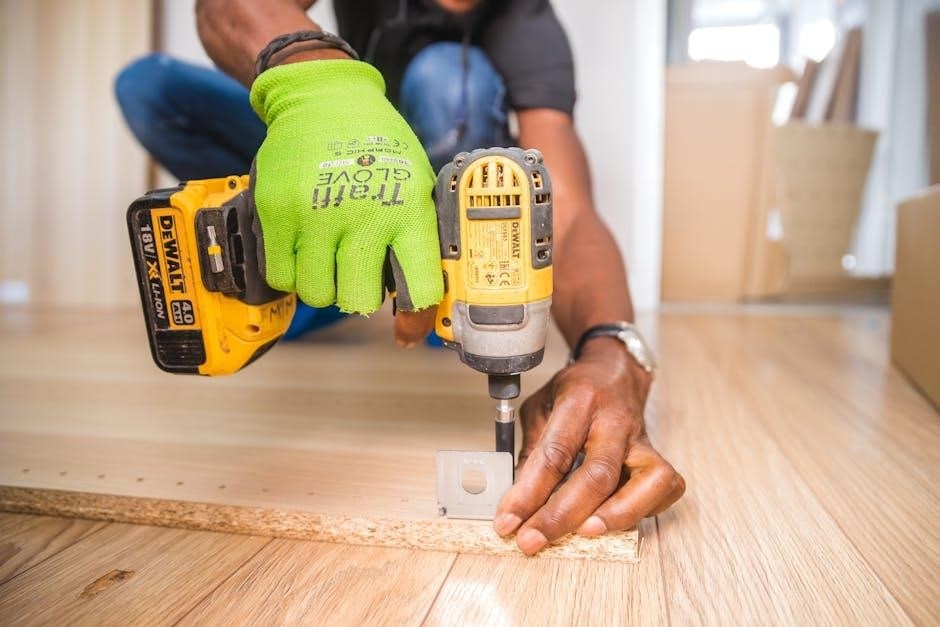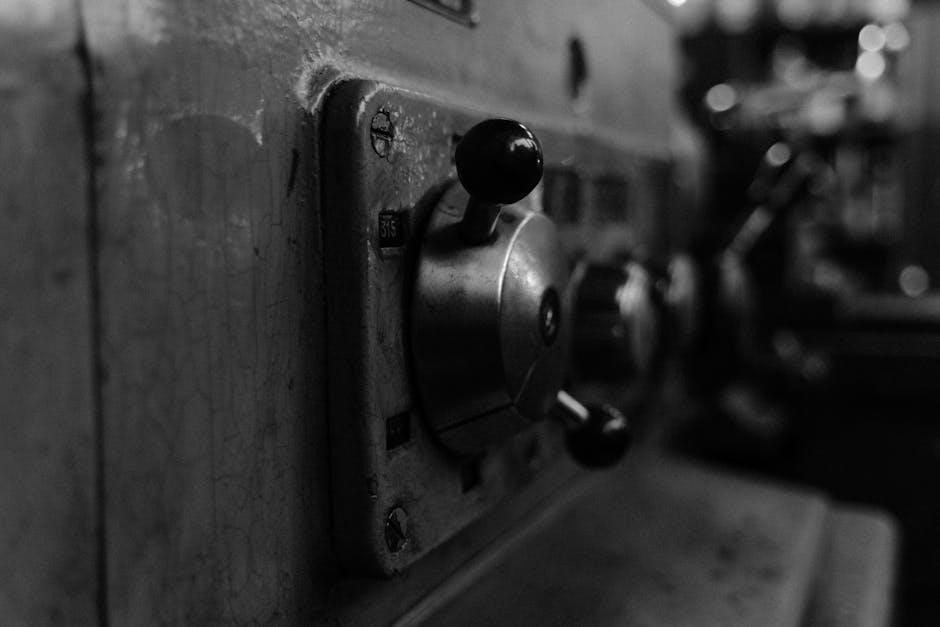A precision drill guide is a tool designed to ensure accurate and consistent drilling operations. It enhances efficiency and reduces errors in various industries, from metalworking to woodworking, by providing precise alignment and consistency in drilling tasks. This essential instrument is crucial for projects requiring exact hole placement and uniformity, making it a vital component in modern manufacturing and craftsmanship.

Advantages of Using a Precision Drill Guide
A precision drill guide offers numerous benefits, primarily enhancing accuracy and consistency in drilling operations. It minimizes errors and ensures precise hole placement, which is critical for professional and DIY projects. By maintaining proper alignment, it reduces the risk of costly mistakes and material waste. The tool also streamlines workflows, saving time and effort by eliminating the need for repeated measurements. Its versatility allows it to work with various materials, including metal, wood, and plastic, making it a valuable asset across industries. Additionally, it simplifies complex drilling tasks, enabling users of all skill levels to achieve professional-quality results. The guide also extends tool life by preventing misalignment-related wear on drill bits. Overall, a precision drill guide is a cost-effective solution that improves efficiency, safety, and the quality of finished products.
How It Works
A precision drill guide operates by aligning the drill bit with pre-set bushings or templates, ensuring accurate hole placement. It attaches to the workpiece or drill press, guiding the bit through precise alignment, reducing errors, and improving stability during drilling operations.
Types of Precision Drill Guides
Precision drill guides come in various types, each designed for specific applications. Mechanical drill guides are the most common, offering precise alignment through bushings. Magnetic drill guides are ideal for Ferrous metals, holding the guide firmly without clamps. Adjustable drill guides allow for customizable drilling patterns, while fixed guides are best for repetitive tasks. For intricate projects, template guides are used, ensuring exact hole placement. Pneumatic drill guides enhance stability in heavy-duty applications, while laser-guided systems provide visual accuracy. Each type caters to different materials and drilling needs, ensuring optimal performance and precision in woodworking, metalworking, or industrial settings. Choosing the right drill guide depends on the material, drill press type, and desired level of accuracy.

Installation and Setup
Installing a precision drill guide involves unboxing, calibrating, and securely mounting it to the drill press. Proper alignment and testing ensure accuracy and safety during operations.
Step-by-Step Instructions
Begin by unboxing and inspecting the precision drill guide. Mount it securely to your drill press, ensuring alignment with the spindle. Tighten all fasteners firmly. Next, calibrate the guide by setting the zero point using a reference object like a gauge block. Perform a test drill on scrap material to verify accuracy. Adjust the guide as needed for proper alignment and squareness. Finally, operate the drill press carefully, maintaining consistent pressure to achieve precise results. Regular checks and maintenance ensure optimal performance over time. Always follow the manufacturer’s instructions for specific models to guarantee safety and accuracy in drilling operations.

Calibration and Maintenance
Calibrating your precision drill guide ensures accuracy and extends its lifespan. Begin by aligning the guide with the spindle axis of your drill press. Use a dial indicator to check for squareness and adjust as necessary. Regularly inspect and clean the guide to remove debris. Lubricate moving parts to prevent wear and tear. Check for any loose connections and tighten them. For optimal performance, recalibrate after extended use or when switching materials. Store the guide in a dry, cool place to avoid rust or damage. Following a maintenance schedule ensures consistent drilling results and maintains the precision of your equipment. Proper care and calibration are essential for achieving professional-grade outcomes in your projects. Regular maintenance also prevents costly repairs and downtime, ensuring your precision drill guide remains a reliable tool.
Applications and Use Cases
Precision drill guides are widely used in metalworking, woodworking, and aerospace industries. They enable accurate hole drilling, alignment, and spacing, ensuring consistency in intricate projects and large-scale manufacturing.
For Different Materials
Precision drill guides are adaptable to various materials, ensuring accurate drilling in metals, plastics, wood, and composites. For metals like steel and aluminum, they maintain alignment and prevent drift. With plastics, they minimize melting and deformation, while in woodworking, they help avoid splintering. For glass or ceramics, the guide ensures controlled, crack-free drilling. Adjustable stops and bushings accommodate different material thicknesses and drill bit sizes, optimizing performance across diverse applications. This versatility makes precision drill guides indispensable in industries like aerospace, automotive, and construction, where material-specific drilling requirements are critical. By tailoring settings to the material, users achieve consistent, high-quality results, enhancing overall productivity and precision in their projects.
Across Various Industries
Precision drill guides are widely used across multiple industries, including aerospace, automotive, manufacturing, and medical sectors, where exact drilling is critical. In aerospace, they ensure precise alignment for aircraft components, while in automotive, they aid in producing engine parts and chassis with high accuracy. For manufacturing, they optimize production efficiency and reduce material waste. In the medical field, they assist in creating surgical instruments and implants with utmost precision. Additionally, industries like construction and electronics benefit from their use, ensuring accurate hole placement in building materials and circuit boards. Their versatility and reliability make them indispensable tools, enabling industries to meet stringent quality and safety standards while enhancing overall production quality and reliability.
Choosing the Right Drill Guide
Selecting the ideal precision drill guide involves considering material compatibility, size, and adjustability. Ensure it fits your drill bits and workpiece thickness for optimal performance and accuracy.
Factors to Consider
When selecting a precision drill guide, several factors are crucial to ensure optimal performance. First, consider the type of material you’ll be drilling, as different guides are designed for metals, woods, or plastics. The drill bit size and shank compatibility are also essential to prevent slippage during operation. Additionally, the guide’s adjustability and alignment features should align with your project’s requirements for accuracy. Durability and build quality are important for long-term use, and ease of setup and calibration should not be overlooked. Finally, assess the guide’s versatility across various applications and industries to ensure it meets your specific needs. These factors collectively ensure the right tool is chosen for precise and efficient drilling operations.
Pros and Cons of Different Types
Precision drill guides come in various types, each with unique advantages and drawbacks. Magnetic drill guides offer portability and ease of use but may lack stability on non-ferrous materials. Mechanical guides provide high accuracy and versatility but often require more setup time. Laser-guided models ensure pinpoint precision but can be costly and complex to calibrate. Adjustable guides are ideal for multiple drill bit sizes but may compromise on rigidity. Fixed guides are durable and simple but limited to specific bit diameters. Understanding these trade-offs helps users choose the most suitable tool for their specific needs, balancing factors like cost, ease of use, and required precision levels. Each type excels in particular scenarios, making the right selection crucial for optimal drilling results.

Safety Precautions
When using a precision drill guide, safety is paramount to prevent accidents and ensure effective operation. Always wear protective gear, including safety glasses and gloves, to guard against flying debris or tool slippage. Ensure the workpiece is securely clamped to prevent movement during drilling, which could lead to injury or damage. Keep loose clothing and long hair tied back to avoid entanglement with the drill; Maintain a clean workspace to reduce tripping hazards and ensure clear visibility. Never overreach or apply excessive force, as this can cause loss of control. Regularly inspect the drill guide and bits for wear or damage, replacing them as needed to avoid malfunctions. Follow the manufacturer’s instructions for setup and operation, and keep children and pets away from the work area. Proper adherence to these precautions ensures a safe and efficient drilling process.

Tips for Optimal Use
For optimal use of a precision drill guide, ensure proper alignment and secure clamping of the workpiece to maintain accuracy. Use high-quality drill bits suitable for the material being drilled to minimize wear and tear. Regularly clean and lubricate the guide to prevent corrosion and ensure smooth operation. Calibrate the drill guide periodically to maintain precision and accuracy. Avoid overloading the drill, as this can lead to misalignment or damage. Use a steady, consistent drilling motion to achieve clean, precise holes. Store the drill guide in a dry, protected area to prevent rust or damage. Always refer to the manufacturer’s guidelines for specific materials and thicknesses. By following these tips, you can extend the lifespan of your precision drill guide and achieve professional-grade results in your projects.
Troubleshooting Common Issues
When using a precision drill guide, common issues may arise, such as misalignment, wear on the guide, or inconsistent drilling results. To address misalignment, recalibrate the guide according to the manufacturer’s instructions. For wear and tear, inspect and replace worn-out bushings or components. If experiencing vibration, ensure the workpiece is securely clamped and the guide is stable. In cases of drill bit slippage, check that the bit is properly seated and aligned. Oversized holes may result from using a drill bit larger than recommended; always verify bit size compatibility. For stuck or jammed parts, apply a small amount of lubricant and gently disassemble. Regular maintenance, such as cleaning and lubricating moving parts, can prevent many of these issues. By addressing these problems promptly, you can maintain the accuracy and efficiency of your precision drill guide.
A precision drill guide is an indispensable tool for achieving accuracy and efficiency in drilling tasks. Its ability to ensure consistent and precise hole placement makes it a valuable asset across various industries and applications. By understanding its advantages, proper setup, and maintenance, users can maximize its performance. Regular calibration and adherence to safety guidelines further enhance its effectiveness. Whether for professional or amateur use, a precision drill guide is a reliable solution for improving the quality of work. Its versatility and durability make it a worthwhile investment for anyone seeking to elevate their drilling operations to the next level of precision and reliability.
